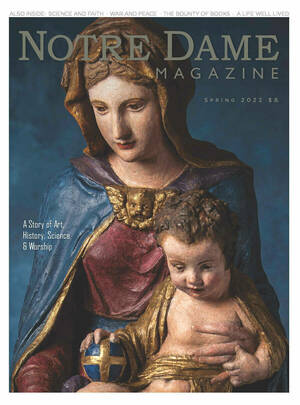
There had been two funerals. When I got home from the second, I told my wife I wanted to sit for a while. But there was too much winter on that Friday evening to sit outside. So I stood and looked out the bedroom window; I was on pause. Sometimes you just have to stop and be alone.
Sometimes life floods into you faster than you’re ready for, and you have to take time to catch up to it. Or let your brain catch up and find its footing, after the heart has been jarred by change. So we say we need to let things “sink in.”
I guess that’s what I sought that evening after the funeral, after the rites of death, the signs of time passing, an altar surrounded by priests I’ve known for decades, the faint traces of a personal Notre Dame history, the pews full of old friends — and the ghosts of others now missing. Tattered linens fluttering on a farmstead clothesline came to mind, as did kites whisked off on the wind: lifetimes as fleeting and insubstantial and pretty as that.
So much to process, to sort through.
There were treetops outside the bedroom window that evening, bare limbs and a snow-covered yard below, cold-looking and stark as the sky faded to dark. It is best not to look away, or seek distractions — at least until the goods have settled in.
In Letters to a Young Poet, the Austrian writer Rainer Maria Rilke said that a feeling of deep sadness was the soul’s way of shutting down while change infiltrates and occupies the psyche. It is best to remain quiet and receptive, he wrote, and to let yourself feel it.
I’ve sat a lot in recent years. I sit outside and look at the sky and watch the treetops sway as breezes riffle through the topmost branches and leaves. I could not claim to meditate or pray. I sit still and watch, my thoughts as fleeting as birds or clouds.
There is no theme to this edition of the magazine; it started as an assembly of random parts. But connections seemed to emerge as I read page proofs in the days after that somber Friday. I saw how Gerry Straub’s retreat to Sant’Isidoro and his response to a van Gogh landscape were akin to the riverside experience that Steve Adams writes about. Both writers speak of transcendence. Both of changed lives. Chris Baglow cites Niels Stensen’s vision at the intersection of science and faith to guide our way forward as we try to understand the universe, while Maryanne Wolf points to the visions possible to those who read deeply as they seek human truths worth living for.
I had glanced dismissively at the Madonna and Child sculpture during dozens of visits to the Snite Museum of Art. But it wasn’t until Joe Becherer, the museum’s director, handed us photos that I paid attention to the postures of the mother and child, the tilts of the heads and the dynamic captured in that 3-foot, stucco statue. And it wasn’t until John Nagy, our managing editor, told the story of this 500-year-old work of art that it acquired meanings I had not known before.
If a theme could be pulled from this issue, I suppose it is that: Be still and look closely.
Kerry Temple is editor of this magazine.